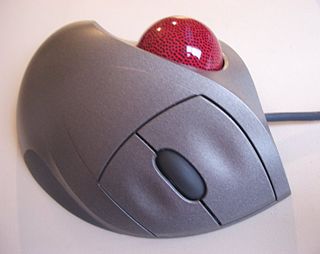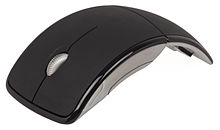
A pointing device is a human interface device that allows a user to input spatial data to a computer. Graphical user interfaces (GUI) and CAD systems allow the user to control and provide data to the computer using physical gestures by moving a hand-held mouse or similar device across the surface of the physical desktop and activating switches on the mouse. Movements of the pointing device are echoed on the screen by movements of the pointer and other visual changes. Common gestures are point and click and drag and drop.

A trackball is a pointing device consisting of a ball held by a socket containing sensors to detect a rotation of the ball about two axes—like an upside-down ball mouse with an exposed protruding ball. Users roll the ball to position the on-screen pointer, using their thumb, fingers, or the palm of the hand, while using the fingertips to press the buttons.

A graphics tablet is a computer input device that enables a user to hand-draw images, animations and graphics, with a special pen-like stylus, similar to the way a person draws images with a pencil and paper.

A pointing stick is a small analog stick used as a pointing device typically mounted centrally in a computer keyboard. Like other pointing devices such as mice, touchpads or trackballs, operating system software translates manipulation of the device into movements of the pointer on the computer screen. Unlike other pointing devices, it reacts to sustained force or strain rather than to gross movement, so it is called an "isometric" pointing device. IBM introduced it commercially in 1992 on its laptops under the name "TrackPoint", and patented an improved version of it in 1997. It has been used for business laptops, such as Acer's TravelMate, Dell's Latitude, HP's EliteBook and Lenovo's ThinkPad.

A touchpad or trackpad is a type of pointing device. Its largest component is a tactile sensor: an electronic device with a flat surface, that detects the motion and position of a user's fingers, and translates them to 2D motion, to control a pointer in a graphical user interface on a computer screen. Touchpads are common on laptop computers, contrasted with desktop computers, where mice are more prevalent. Trackpads are sometimes used on desktops, where desk space is scarce. Because trackpads can be made small, they can be found on personal digital assistants (PDAs) and some portable media players. Wireless touchpads are also available, as detached accessories.
Synaptics Incorporated is a publicly owned San Jose, California-based developer of human interface (HMI) hardware and software, including touchpads for computer laptops; touch, display driver, and fingerprint biometrics technology for smartphones; and touch, video and far-field voice technology for smart home devices and automotives. Synaptics sells its products to original equipment manufacturers (OEMs) and display manufacturers.

The Apple Mouse is a multi-control USB mouse manufactured by Mitsumi Electric and sold by Apple Inc. It was announced and sold for the first time on August 2, 2005, and a Bluetooth version was available from 2006 to 2009. Before the Mighty Mouse, Apple had sold only one-button mice with its computers, beginning with the Apple Lisa 22 years earlier. The Mighty Mouse supported two buttons, and a miniature trackball for scrolling.
Microsoft IntelliPoint is the Microsoft-branded software driver for the company's hardware mice. Microsoft has released versions for both Windows and Mac OS X. It has been succeeded by Microsoft Mouse and Keyboard Center, which combines IntelliType with IntelliPoint.

In computing, multi-touch is technology that enables a surface to recognize the presence of more than one point of contact with the surface at the same time. The origins of multitouch began at CERN, MIT, University of Toronto, Carnegie Mellon University and Bell Labs in the 1970s. CERN started using multi-touch screens as early as 1976 for the controls of the Super Proton Synchrotron. Capacitive multi-touch displays were popularized by Apple's iPhone in 2007. Multi-touch may be used to implement additional functionality, such as pinch to zoom or to activate certain subroutines attached to predefined gestures using gesture recognition.

IntelliMouse is a series of computer mice from Microsoft. The IntelliMouse series is credited with a number of innovations; Microsoft was among the first mouse vendors to introduce a scroll wheel, an optical mouse, and dedicated auxiliary buttons on the side of the mouse. They use IntelliPoint drivers and its main competitor through the years has been Logitech.

Apple Inc. has designed and manufactured several models of mice, trackpads, and other pointing devices, primarily for use with Macintosh computers. Over the years, Apple has maintained a distinct form and function with its mice that reflect their design languages of that time. Apple's current external pointing devices are the Magic Mouse 2 and Magic Trackpad 2.
Courier was a prototype concept by Microsoft for a dual-touchscreen tablet. The device was conceived as being a digital notebook, consisting of two 7-inch touchscreens hinged together like a book, and running a custom operating system built primarily around handwriting input and a notebook-like journal for storing notes, images, and clippings from web pages.

Microsoft Tablet PC is a term coined by Microsoft for tablet computers conforming to a set of specifications announced in 2001 by Microsoft, for a pen-enabled personal computer, conforming to hardware specifications devised by Microsoft and running a licensed copy of Windows XP Tablet PC Edition operating system or a derivative thereof.

A 2-in-1 laptop, also known as 2-in-1 PC, 2-in-1 tablet, laplet, tabtop, laptop tablet, or simply 2-in-1, is a portable computer that has features of both tablets and laptops.

Microsoft Surface is a line of personal computers, tablets, and interactive whiteboards designed and developed by Microsoft, most of them running the Windows operating system. They are designed to be premium devices that set examples for manufacturers of other Windows-compatible products. It comprises several generations of hybrid tablets, 2-in-1 detachable notebooks, a convertible desktop all-in-one, an interactive whiteboard, and various accessories, many with unique form factors. The majority of devices in the Surface lineup are based on Intel processors and compatible with Windows 10 or Windows 11.

The Surface Pro 2 is a Surface-series 2-in-1 detachable produced by Microsoft. Unveiled at an event in New York City on September 23, 2013 and released on October 22, 2013, it succeeds the Surface Pro released in February 2013. While maintaining a design similar to the original design of its predecessor, the Surface Pro 2 has improved hardware specifications compared to it, such as a Haswell Intel Core processor and an increased number of storage options, improved versions of the kickstand and cover accessories.

An active pen is an input device that includes electronic components and allows users to write directly onto the display of a computing device such as a smartphone, tablet computer or ultrabook. The active pen marketplace has long been dominated by N-trig and Wacom, but newer firms Atmel and Synaptics also offer active pen designs.

The Surface Pro 3 is the third-generation Surface-series 2-in-1 detachable, designed, developed, marketed, and produced by Microsoft. It originally ran the Windows 8.1 Pro operating system (OS), but the optional upgrade to Windows 10 Pro (OS) operating system was later added.

The Surface Laptop is a laptop computer designed by Microsoft as part of the company's Surface line of personal computing devices. When it debuted, the laptop was intended to compete with Apple's MacBook Air and MacBook Pro.
















